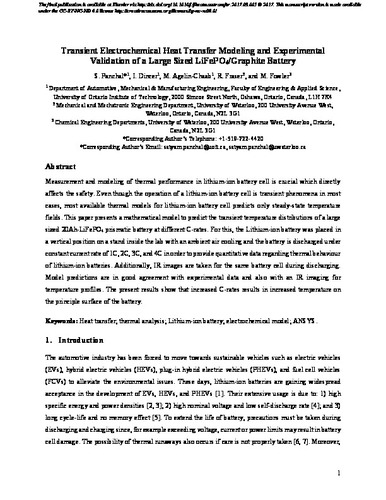UWSpace will be migrating to a new version of its software from July 29th to August 1st. UWSpace will be offline for all UW community members during this time.
Transient electrochemical heat transfer modeling and experimental validation of a large sized LiFePO4/graphite battery
| dc.contributor.author | Panchal, Satyam | |
| dc.contributor.author | Dincer, Ibrahim | |
| dc.contributor.author | Agelin-Chaab, Martin | |
| dc.contributor.author | Fraser, Roydon | |
| dc.contributor.author | Fowler, Michael | |
| dc.date.accessioned | 2018-01-12 13:46:18 (GMT) | |
| dc.date.available | 2018-01-12 13:46:18 (GMT) | |
| dc.date.issued | 2017-06-01 | |
| dc.identifier.uri | http://dx.doi.org/10.1016/j.ijheatmasstransfer.2017.03.005 | |
| dc.identifier.uri | http://hdl.handle.net/10012/12842 | |
| dc.description | The final publication is available at Elsevier via http://dx.doi.org/10.1016/j.ijheatmasstransfer.2017.03.005 © 2017. This manuscript version is made available under the CC-BY-NC-ND 4.0 license http://creativecommons.org/licenses/by-nc-nd/4.0/ | en |
| dc.description.abstract | Both measurement and modeling of thermal performance in lithium-ion battery cell are considered crucial as they directly affect the safety. Even though the operation of a lithium-ion battery cell is transient phenomena in most cases, most available thermal models for lithium-ion battery cell predicts only steady-state temperature fields. This paper presents a mathematical model to predict the transient temperature distributions of a large sized 20Ah-LiFePO4 prismatic battery at different C-rates. In this regard, the lithium-ion battery is placed in a vertical position on a stand inside the lab with an ambient air cooling and the battery is discharged under constant current rate of 1C, 2C, 3C, and 4C in order to provide quantitative data regarding thermal behavior of lithium-ion batteries. Additionally, IR images are taken for the same battery cell during discharging. The present model predictions are in very good agreement with the experimental data and also with an IR imaging for temperature profiles. The present results show that the increased C-rates result in increased temperatures on the principle surface of the battery. (C) 2017 Elsevier Ltd. All rights reserved. | en |
| dc.language.iso | en | en |
| dc.publisher | Elsevier | en |
| dc.rights | Attribution-NonCommercial-NoDerivatives 4.0 International | * |
| dc.rights.uri | http://creativecommons.org/licenses/by-nc-nd/4.0/ | * |
| dc.subject | Heat transfer | en |
| dc.subject | Thermal analysis | en |
| dc.subject | Lithium-ion battery | en |
| dc.subject | Electrochemical model | en |
| dc.subject | Temperature distribution | en |
| dc.title | Transient electrochemical heat transfer modeling and experimental validation of a large sized LiFePO4/graphite battery | en |
| dc.type | Article | en |
| dcterms.bibliographicCitation | Panchal, S., Dincer, I., Agelin-Chaab, M., Fraser, R., & Fowler, M. (2017). Transient electrochemical heat transfer modeling and experimental validation of a large sized LiFePO 4 /graphite battery. International Journal of Heat and Mass Transfer, 109, 1239–1251. https://doi.org/10.1016/j.ijheatmasstransfer.2017.03.005 | en |
| uws.contributor.affiliation1 | Faculty of Engineering | en |
| uws.contributor.affiliation2 | Mechanical and Mechatronics Engineering | en |
| uws.typeOfResource | Text | en |
| uws.typeOfResource | Text | en |
| uws.peerReviewStatus | Reviewed | en |
| uws.scholarLevel | Post-Doctorate | en |


